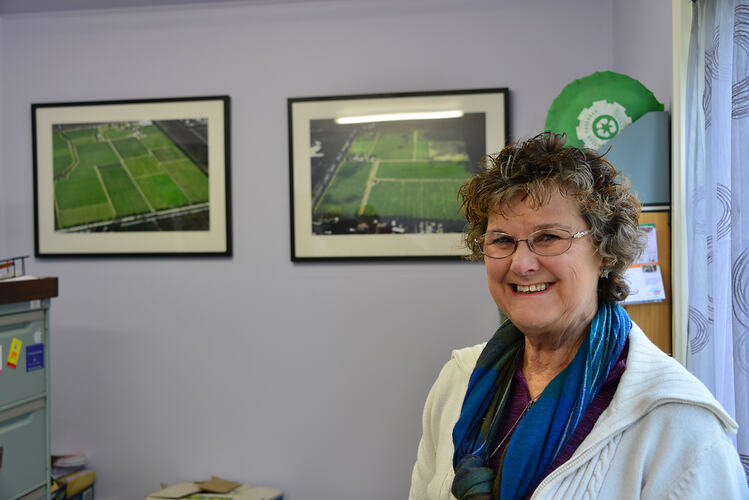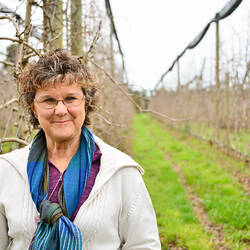Summary
This image is one of three photographs of Rien Silverstein at Orrvale taken by Tagen Baker on 12 August 2016 as part of The Invisible Farmer Project.
This particular image shows Rien Silverstein standing in her home in Orrvale, showcasing two aerial photographs on her wall of her orchards in Orville and Tatura. Together these aerial images represent the special item of value that Rien chose to highlight during her interview.
Originally from New South Wales, Rien Silverstein relocated to Victoria after meeting her husband, Morris, who is a fourth generation horticulture farmer. Together, Rein and Morris farm apples and pears on two orchards in Orrvale and Tatura, spread over a total of 78 hectares. Rien speaks passionately about sustainability, land use and care, irrigation/water issues, and the importance of community involvement and social activism within the agriculture industry.
This photograph is part of Museums Victoria's Invisible Farmer Project Collection. The Invisible Farmer Project was the largest ever study of Australian women on the land, uncovering the histories and stories of Australian women in agriculture. It began as a pilot project (2015-2016) and evolved into a three year (2017-2020) nation-wide partnership between rural communities, academic, government and cultural organisations, funded by the Australian Research Council.
Description of Content
Woman standing to the right side of a room with two aerial photographs of grass fields hanging on the wall behind her.
Physical Description
Digital colour photograph
Significance
As a visiting research associate for Museum Victoria, and a PhD student in Utah State University's Department of Environment and Society, Tagen Baker had the opportunity to explore the diverse landscape of Victoria and interview and photograph women farmers as part of The Invisible Farmer Project-to learn from them about their histories, responses to climate change, and how they adapted their agricultural practices to sustain themselves and their families. Tagen wanted to know how their experiences have been similar or different to women in her home state of Idaho, USA. How have women been key agents of change embedded in their environments? How do women farmers provide unique perspectives and contributions to the futures of agriculture and to their communities?
As part of her research process, Tagen asked several women farmers if she could photograph them with an item of value. This item opened up a unique opportunity to communicate and learn about the farmers' lives. The item chosen was not only symbolic as a physical item of value, tangible and necessary, but a portal into a storytelling journey, a symbol of their rich and unique life experiences.
More Information
-
Collection Names
-
Collecting Areas
-
Photographer
-
Format
Digital file, Colour
-
Classification
-
Category
-
Discipline
-
Type of item
-
References
[Link 1] Last viewed: 6.4.17.
-
Keywords
Women Farmers, Women in Agriculture, Women's Issues, Women on Farms, Rural Women, Agriculture & Farming, Farmers

